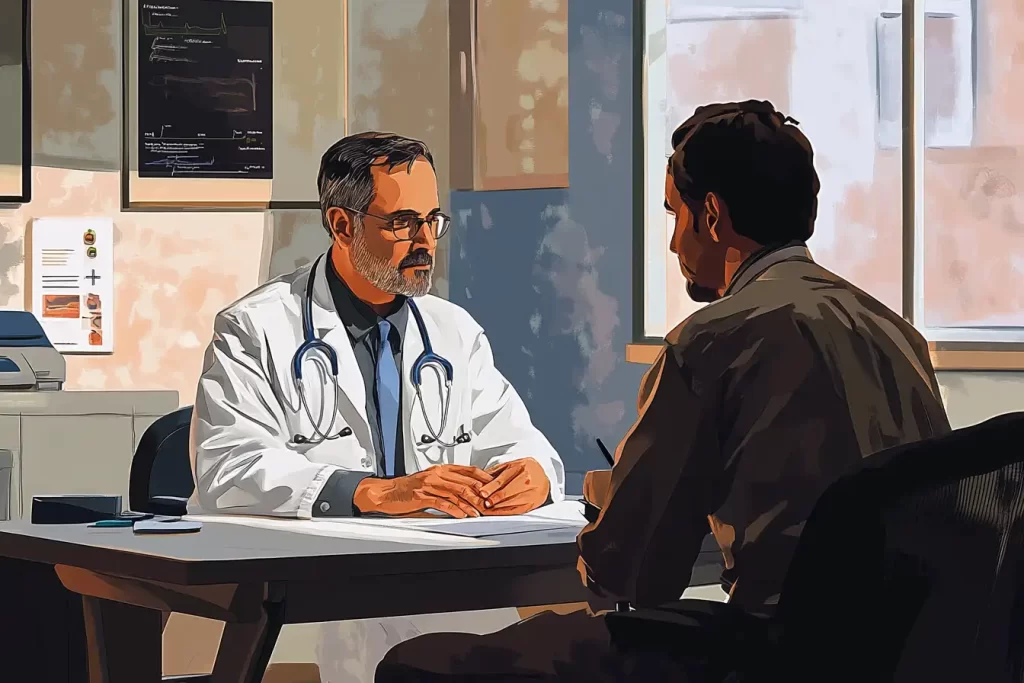Prostate cancer is one of the most common cancers affecting men worldwide, with millions of new cases diagnosed each year. This disease develops in the prostate gland, a small organ responsible for producing seminal fluid. While factors like age, genetics, and ethnicity play significant roles in determining your risk, there are many steps you can take to lower the chances of facing this diagnosis. Understanding how to reduce the risk of developing prostate cancer empowers you to take control of your health and make informed lifestyle choices.
Incorporating healthy habits and staying proactive can make a measurable difference in preventing prostate cancer. From adopting a nutrient-rich diet and maintaining an active lifestyle to scheduling regular screenings, the path to reducing risk is both achievable and practical. Early detection and prevention strategies can improve outcomes and provide peace of mind.
In this article, you will learn:
- Simple lifestyle changes that lower prostate cancer risk
- How diet and exercise influence prostate health
- The importance of regular screenings and early detection
Let’s explore these seven effective strategies on how to reduce the risk of developing prostate cancer and protect your long-term health.

1. Understanding Prostate Cancer
What is Prostate Cancer?
Prostate cancer is a form of cancer that develops in the prostate gland, a small walnut-sized organ located beneath the bladder and in front of the rectum. The prostate is responsible for producing seminal fluid, which nourishes and transports sperm during ejaculation. When the cells in the prostate begin to grow uncontrollably, they form tumors that can be benign (non-cancerous) or malignant (cancerous).
Prostate cancer typically progresses slowly, and many men with early-stage prostate cancer may not experience noticeable symptoms. However, in some cases, the cancer can grow rapidly and spread to other parts of the body, such as the bones, lymph nodes, and other organs. Early detection is critical for successful treatment and management.
Types of Prostate Cancer
- Adenocarcinoma – The most common type of prostate cancer, originating in the gland cells responsible for producing seminal fluid.
- Small Cell Carcinomas – A rare and aggressive form of prostate cancer.
- Transitional Cell Carcinomas – Cancer that begins in the cells lining the urethra and may spread to the prostate.
- Sarcomas – Rare cancers that develop in the soft tissue or connective tissue of the prostate.
Key Risk Factors for Prostate Cancer
Several factors influence your likelihood of developing prostate cancer. Understanding these risks can help you take proactive steps to protect yourself.
- Age:
- The risk increases significantly after age 50. About 60% of cases are diagnosed in men over 65.
- Family History:
- If a father, brother, or close relative has had prostate cancer, your risk more than doubles. Genetic mutations, such as BRCA1 and BRCA2, can also play a role.
- Ethnicity:
- African American men are more likely to develop prostate cancer and often experience more aggressive forms of the disease. They also tend to be diagnosed at younger ages compared to other groups.
- Diet and Lifestyle:
- Diets high in red meat, processed foods, and high-fat dairy products may increase risk, while a healthy diet and active lifestyle can help reduce it.
- Hormones:
- Higher levels of testosterone and other hormones can promote prostate cell growth, which may increase cancer risk.
- Environmental Factors:
- Exposure to certain chemicals, such as pesticides or industrial toxins, can contribute to increased risk.
Symptoms of Prostate Cancer
Prostate cancer often doesn’t present symptoms in its early stages. However, as the disease progresses, symptoms may include:
- Frequent urination, especially at night
- Difficulty starting or stopping urination
- Weak or interrupted urine flow
- Painful urination or ejaculation
- Blood in urine or semen
- Persistent pain in the lower back, hips, or pelvis
Early detection is key. If you experience any of these symptoms, consult a healthcare professional for a thorough evaluation.
2. Adopt a Healthy Lifestyle
Exercise Regularly
Regular physical activity plays a crucial role in reducing cancer risk, maintaining a healthy weight, and supporting overall health. Exercise helps regulate hormones, reduce inflammation, and improve immune function—all of which are essential for prostate health.
Recommended Exercise Guidelines
- Aerobic Exercise: Aim for at least 150 minutes per week of moderate-intensity aerobic exercise, such as brisk walking, jogging, cycling, or swimming. If you prefer vigorous activities like running or high-intensity interval training (HIIT), 75 minutes per week is sufficient.
- Strength Training: Include 2-3 strength training sessions per week to build muscle and maintain bone density. Exercises like weightlifting, push-ups, and resistance band workouts can help.
- Flexibility and Balance: Activities like yoga, tai chi, and stretching exercises improve flexibility, reduce stress, and promote relaxation, which can benefit your overall health.
Exercise Tips for Beginners
- Start Slow: If you’re new to exercise, begin with light activities such as walking or gentle stretching, and gradually increase intensity.
- Make it Fun: Choose activities you enjoy, whether it’s dancing, swimming, or hiking, to stay motivated.
- Stay Consistent: Regularity is more important than intensity. Aim to move your body every day, even if it’s just a short walk.
Maintain a Healthy Weight
Excess body weight, particularly around the abdomen, is linked to an increased risk of aggressive prostate cancer. Obesity can lead to hormonal imbalances and inflammation, both of which may contribute to cancer development.
Tips for Achieving a Healthy Weight
- Balanced Diet: Focus on whole, nutrient-dense foods, including vegetables, fruits, whole grains, lean proteins, and healthy fats.
- Portion Control: Be mindful of portion sizes and avoid overeating. Consider using smaller plates to help manage portions.
- Mindful Eating: Pay attention to hunger and fullness cues. Avoid distractions like screens during meals.
- Stay Hydrated: Drinking plenty of water helps with metabolism and prevents overeating.
Limit Alcohol Consumption
Excessive alcohol consumption has been linked to an increased risk of several types of cancer, including prostate cancer. While moderate alcohol intake may not significantly increase risk, it’s best to limit consumption to support overall health.
Recommended Guidelines
- Moderate Consumption: Limit alcohol to no more than 2 drinks per day for men. One drink is equivalent to:
- 12 ounces of beer
- 5 ounces of wine
- 1.5 ounces of distilled spirits
Tips for Reducing Alcohol Intake
- Set Limits: Establish a weekly limit and stick to it.
- Explore Alternatives: Enjoy non-alcoholic options like sparkling water with lemon, herbal teas, or mocktails.
- Social Support: Let friends and family know about your goal to reduce alcohol, and seek their support.
Quit Smoking
Smoking is a known risk factor for various cancers, including aggressive forms of prostate cancer. The chemicals in cigarettes damage DNA and promote inflammation, which can lead to cancer growth. The sooner you quit, the sooner your body begins to heal.
Benefits of Quitting Smoking
- Within 1 Year: Your risk of heart disease drops significantly.
- Within 5 Years: Your risk of several cancers, including bladder and throat cancer, is cut in half.
- Long-Term: Over time, your risk of developing aggressive prostate cancer decreases.
Tips for Quitting Smoking
- Set a Quit Date: Choose a specific date to quit and prepare mentally and physically.
- Use Support Resources: Consider nicotine replacement therapies, counseling, or support groups.
- Stay Active: Exercise can help reduce cravings and manage stress.
- Avoid Triggers: Identify situations or activities that trigger the urge to smoke and develop strategies to cope.
Get Enough Sleep
Sleep is often overlooked, but it plays a vital role in maintaining overall health and reducing cancer risk. Poor sleep can disrupt hormone regulation and weaken the immune system, increasing the risk of disease.
Sleep Tips for Better Health
- Aim for 7-8 Hours: Prioritize getting 7-8 hours of quality sleep each night.
- Maintain a Routine: Go to bed and wake up at the same time every day.
- Create a Relaxing Environment: Ensure your bedroom is dark, quiet, and cool. Avoid screens and bright lights before bedtime.
- Relaxation Techniques: Incorporate relaxation practices like deep breathing, meditation, or reading before bed.
Manage Stress
Chronic stress can negatively impact your immune system, increase inflammation, and contribute to poor health outcomes. Managing stress is crucial for reducing the risk of prostate cancer and improving overall well-being.
Stress-Reduction Techniques
- Mindfulness Meditation: Spend 10-15 minutes each day practicing mindfulness or guided meditation.
- Exercise: Physical activity is a natural stress reliever.
- Hobbies: Engage in activities that bring you joy, such as gardening, painting, or playing music.
- Social Connections: Spend time with supportive friends and family members.
- Counseling: Don’t hesitate to seek professional help if stress becomes overwhelming.

3. Make Smart Dietary Choices
Foods to Include for Prostate Health
Incorporating nutrient-dense foods with cancer-fighting properties can help lower the risk of prostate cancer. Focus on the following:
1. Tomatoes and Lycopene-Rich Foods
Tomatoes contain lycopene, a powerful antioxidant that has been shown to help reduce prostate cancer risk. Lycopene is more readily absorbed by the body when tomatoes are cooked.
- Sources: Cooked tomatoes, tomato sauce, tomato paste, and sun-dried tomatoes.
- Tips: Add tomato sauce to pasta, soups, or stews, or enjoy a bowl of tomato soup regularly.
2. Cruciferous Vegetables
Cruciferous vegetables contain sulforaphane and indole-3-carbinol, compounds that help detoxify the body and inhibit the growth of cancer cells.
- Sources: Broccoli, cauliflower, Brussels sprouts, kale, and cabbage.
- Tips: Steam or stir-fry these vegetables to retain nutrients. Add them to salads, stir-fries, or side dishes.
3. Omega-3 Fatty Acids
Omega-3 fatty acids reduce inflammation, support heart health, and may lower prostate cancer risk.
- Sources: Fatty fish like salmon, sardines, mackerel, and trout.
- Tips: Aim to eat fatty fish at least twice a week. If you’re vegetarian, include flaxseeds, chia seeds, and walnuts in your diet.
4. Green Tea
Green tea is rich in catechins, antioxidants that may help prevent prostate cancer by inhibiting the growth of cancer cells.
- Tips: Drink 2-3 cups of green tea per day. Opt for high-quality green tea leaves for maximum benefits.
5. Berries
Berries like strawberries, blueberries, and raspberries are high in antioxidants, which help combat oxidative stress and inflammation.
- Tips: Add berries to yogurt, smoothies, oatmeal, or enjoy them as a snack.
6. Nuts and Seeds
Nuts and seeds provide healthy fats, vitamins, and minerals that support prostate health.
- Sources: Almonds, walnuts, pumpkin seeds, and flaxseeds.
- Tips: A handful of nuts or a tablespoon of seeds can be a nutritious daily snack.
7. Legumes and Soy Products
Legumes such as beans, lentils, and peas are rich in fiber and plant-based proteins. Soy products like tofu and edamame contain isoflavones, which may reduce prostate cancer risk.
- Tips: Replace red meat with plant-based protein sources like beans, lentils, and tofu in meals.
Foods to Limit for Prostate Health
Certain foods can increase the risk of prostate cancer or promote inflammation. Limit these to support prostate health.
1. Red and Processed Meats
Diets high in red meat (beef, pork, lamb) and processed meats (bacon, sausages, hot dogs) have been linked to an increased risk of prostate cancer.
- Why: Cooking meat at high temperatures produces carcinogenic compounds that can damage DNA.
- Tips: Opt for lean poultry, fish, or plant-based proteins instead of red meat. If you eat red meat, avoid charring it and use low-heat cooking methods.
2. High-Fat Dairy Products
Consuming large amounts of full-fat dairy (whole milk, cheese, butter) may increase prostate cancer risk.
- Why: High calcium intake may suppress the production of vitamin D, which plays a role in protecting against cancer.
- Tips: Choose low-fat or plant-based dairy alternatives like almond milk or oat milk.
3. Sugary Foods and Drinks
Excessive sugar intake contributes to obesity and inflammation, which are linked to higher cancer risks.
- Why: High blood sugar levels can fuel the growth of cancer cells.
- Tips: Limit sugary snacks, sodas, and processed desserts. Opt for natural sweeteners like honey or fruits.
4. Fried and Fast Foods
Fried foods are high in unhealthy trans fats and additives that promote inflammation.
- Tips: Limit fried foods and choose healthier cooking methods like baking, grilling, or steaming.
The Role of Supplements
Supplements can support prostate health, but they should not replace a balanced diet. Always consult your healthcare provider before starting supplements.
Key Supplements for Prostate Health
- Vitamin D:
- Why: Helps regulate cell growth and may reduce prostate cancer risk.
- Sources: Sunlight, fatty fish, fortified dairy, or supplements.
- Zinc:
- Why: Supports prostate function and may help prevent inflammation.
- Sources: Pumpkin seeds, shellfish, and supplements.
- Selenium:
- Why: An antioxidant that may reduce cancer risk.
- Sources: Brazil nuts, fish, and supplements.
- Green Tea Extract:
- Why: Contains catechins that may inhibit cancer cell growth.
- Caution: High doses can cause liver issues; consult a doctor.
Sample Daily Meal Plan for Prostate Health
Here’s a simple meal plan incorporating prostate-friendly foods:
- Breakfast: Oatmeal with fresh berries, flaxseeds, and almond milk.
- Lunch: Grilled salmon with steamed broccoli and quinoa.
- Snack: A handful of walnuts and green tea.
- Dinner: Stir-fried tofu with mixed vegetables and brown rice.
- Dessert: A bowl of fresh strawberries.
4. Prioritize Regular Screenings
Why Regular Screenings Matter
Prostate cancer can progress slowly, but in some cases, it may grow aggressively and spread beyond the prostate. Early detection through routine screenings can:
- Identify Cancer Early: Detecting cancer before symptoms appear increases the chances of successful treatment.
- Reduce Mortality Risk: Early-stage prostate cancer is highly treatable, and survival rates are significantly higher.
- Provide Peace of Mind: Regular screenings can reassure you if your results are normal or prompt early intervention if needed.
- Inform Treatment Decisions: If cancer is detected, screenings can help assess the stage and determine the best course of action.
Types of Prostate Cancer Screenings
There are two primary methods for screening prostate cancer: the Prostate-Specific Antigen (PSA) test and the Digital Rectal Exam (DRE). These tests are often used together to increase accuracy and ensure a comprehensive evaluation.
1. Prostate-Specific Antigen (PSA) Test
The PSA test measures the level of PSA, a protein produced by the prostate gland, in the blood. Elevated PSA levels may indicate prostate cancer or other conditions, such as prostatitis (inflammation of the prostate) or benign prostatic hyperplasia (BPH).
Key Points About the PSA Test:
- Normal PSA Levels: Typically, a PSA level below 4.0 ng/mL is considered normal. However, this can vary based on age and other factors.
- Elevated PSA: A higher PSA level doesn’t always mean cancer. Other conditions can cause elevated PSA levels.
- Monitoring Trends: Doctors often look at PSA levels over time to see if there’s a consistent rise, which may prompt further investigation.
Pros of the PSA Test:
- Simple and non-invasive blood test.
- Can detect prostate cancer early before symptoms arise.
Cons of the PSA Test:
- May result in false positives (elevated PSA without cancer).
- May lead to unnecessary biopsies or treatments.
2. Digital Rectal Exam (DRE)
The DRE involves a healthcare provider manually examining the prostate gland through the rectum to feel for any abnormalities, such as lumps, hardness, or changes in size and texture.
Key Points About the DRE:
- Procedure: The doctor inserts a gloved, lubricated finger into the rectum to check the prostate.
- Duration: The exam is quick, typically lasting less than a minute.
- What It Detects: Irregularities in the prostate, such as hard or lumpy areas, which may indicate cancer.
Pros of the DRE:
- Quick and relatively simple exam.
- Can detect abnormalities that may not be reflected in PSA levels.
Cons of the DRE:
- May cause discomfort or embarrassment for some men.
- Not as effective as the PSA test for detecting early-stage prostate cancer.

When to Start Regular Screenings
The appropriate age to begin prostate cancer screenings depends on your risk factors. Here are general guidelines:
- Average Risk:
- Men with no significant risk factors should start screening at age 50.
- Higher Risk:
- Age 45 for men with a family history of prostate cancer (father, brother, or close relatives) or African American men who have a higher risk of aggressive prostate cancer.
- Highest Risk:
- Age 40 for men with multiple close relatives diagnosed with prostate cancer before age 65 or those with known genetic mutations (BRCA1, BRCA2).
Frequency of Screenings:
- PSA Test: Annually or every 2 years, depending on PSA levels and doctor recommendations.
- DRE: Typically performed during annual check-ups if recommended by your doctor.
What to Expect During a Screening
PSA Test Experience:
- Preparation: No special preparation is needed, but avoid vigorous exercise or ejaculation for 48 hours before the test, as these can temporarily raise PSA levels.
- Procedure: A blood sample is drawn from your arm.
- Results: Results are usually available within a few days, and your doctor will explain them and discuss next steps if needed.
DRE Experience:
- Preparation: No specific preparation is required.
- Procedure: The doctor will ask you to stand and bend forward or lie on your side with knees pulled up.
- Discomfort: You may feel mild discomfort or pressure, but the exam is brief.
- Results: Your doctor will discuss any abnormalities and recommend further tests if needed.
What Happens if Results are Abnormal?
Abnormal results from a PSA test or DRE don’t necessarily mean you have prostate cancer. Your doctor may recommend:
- Repeat PSA Test: To confirm results and check trends over time.
- Imaging Tests: Such as MRI or ultrasound to get a clearer picture of the prostate.
- Prostate Biopsy: A sample of prostate tissue is removed and examined under a microscope to determine if cancer is present.
Early diagnosis through these steps can significantly improve outcomes and allow for less invasive treatment options.
Tips for Proactive Screening
- Know Your Risk: Be aware of your family history and other risk factors.
- Ask Questions: Discuss screening options, risks, and benefits with your healthcare provider.
- Stay Consistent: Follow recommended screening schedules based on your risk level.
- Stay Informed: Keep up with the latest research and guidelines on prostate cancer screening.
5. Manage Chronic Health Conditions
Chronic health conditions like diabetes, high blood pressure, and heart disease can increase the risk of developing prostate cancer. Managing these conditions through a healthy lifestyle and medical care is essential.
Steps to Manage Chronic Conditions:
- Stay Active: Exercise helps manage blood sugar and blood pressure levels.
- Follow Prescribed Medications: Take medications as directed by your healthcare provider.
- Monitor Health Regularly: Keep track of your blood pressure, cholesterol, and glucose levels through regular check-ups.
6. Reduce Stress and Prioritize Mental Health
Chronic stress can weaken the immune system and contribute to inflammation, increasing overall health risks, including cancer.
Stress-Reduction Techniques:
- Meditation and Mindfulness: Practices like yoga and meditation can improve mental well-being.
- Adequate Sleep: Aim for 7-8 hours of sleep per night to support your body’s recovery.
- Social Support: Stay connected with friends, family, and support groups to maintain emotional health.
7. Stay Informed and Proactive
Knowledge is a powerful tool in cancer prevention. Stay informed about the latest research, guidelines, and strategies on how to reduce the risk of developing prostate cancer. Regular discussions with your healthcare provider can help you stay proactive and make the best decisions for your health.
Frequently Asked Questions (FAQ)
- At what age should I start screening for prostate cancer?
- Most men should start screening at age 50, or age 45 if you’re at higher risk.
- Can diet really reduce the risk of prostate cancer?
- Yes, a diet rich in fruits, vegetables, and healthy fats can lower your risk.
- Is prostate cancer hereditary?
- Yes, having a close relative with prostate cancer increases your risk.
- How often should I exercise to reduce my risk?
- Aim for at least 150 minutes of moderate exercise per week.
- Are PSA tests accurate?
- They are helpful but can have false positives or negatives. Discuss with your doctor.
Conclusion
Reducing the risk of developing prostate cancer involves adopting a healthy lifestyle, making smart dietary choices, prioritizing regular screenings, and managing overall health. By following these seven effective strategies, you can take proactive steps to protect your prostate health and overall well-being.
Your journey doesn’t end here. If you’re ready to learn more about prostate cancer screenings and early detection, talk to your healthcare provider or explore more resources on men’s health today.


1 thought on “7 Effective Ways on How to Reduce the Risk of Developing Prostate Cancer”